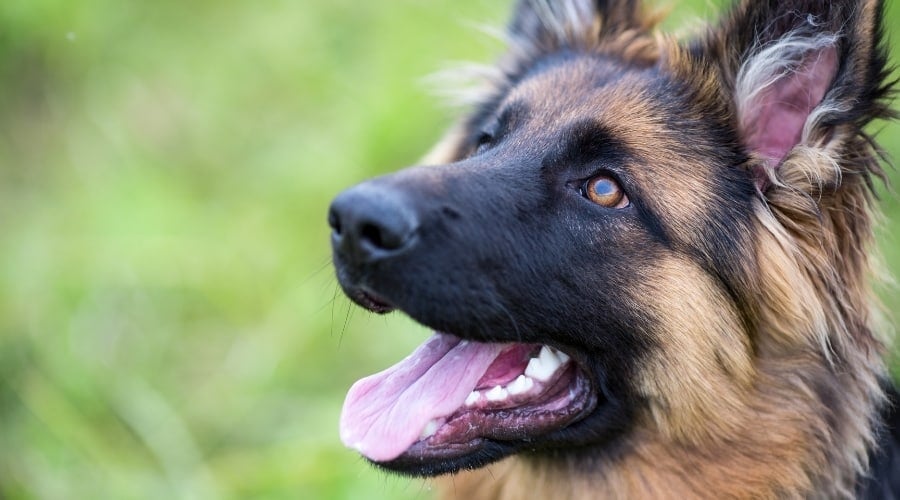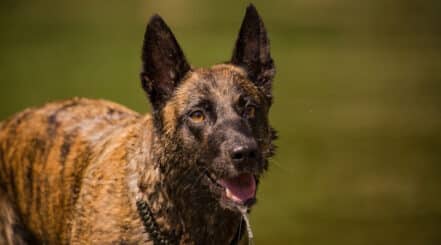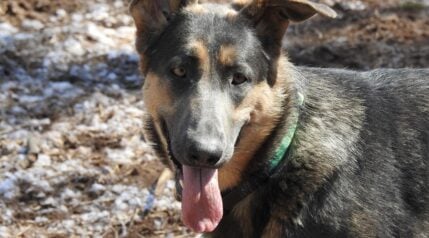Comparing the German Shepherd vs. Belgian Malinois for your next family pet? The Belgian Malinois and the German Shepherd Dog (GSD) may both be from the same Shepherd lineage. Some people even confuse the Malinois for being just a shorter-haired version of the German Shepherd. While these two breeds have some very similar traits, they are quite different in terms of their personalities and lifestyle requirements.
The German Shepherd is one of the most well known and popular dog breeds. They can still be a challenge for a novice dog owner, but they can make great family pets with consistent training and socialization. The Malinois is an even more intensely work driven dog, and they are not generally the best choice of dog for a standard family home.
Adopting either one of these two beautiful breeds is a lifetime commitment. You’ll need to make sure you understand more about both breeds to know if you can offer them a suitable home. Let’s jump in and find out what makes them similar, and also very different.
Breed Comparison
German Shepherd
- Height 22-26 Inches
- Weight 50-90 Pounds
- Temperament Confident, Courageous, Smart
- Energy Intense
- Health Average
- Lifespan 7-10 Years
- Puppy Prices $1,000 and Up
Belgian Malinois
- Height 21-24 Inches
- Weight 40-70 Pounds
- Temperament Courageous, Intelligent, Independent
- Energy Extremely Intense
- Health Above Average
- Lifespan 12-14 Years
- Puppy Prices $1,500 and Up
Breed Histories
The history of the breeds is quite similar. Both were introduced around the same time, and they were developed with a focus on their working abilities. Let’s take a look at the history behind each of the breeds.
German Shepherd

German Shepherds, as the name suggests, originated from Germany. The breed resulted in selective mating of traditional farm dogs that were involved with guarding and herding livestock. The breed, as we know it today, was thought to have been introduced in the late 1800s. It was championed and refined by a club dedicated to the breed that was started by a German Cavalry Officer. The club was also responsible for their promotion as being ideal military and police dogs.
The breed grew in popularity through the 1900s, particularly after the appearance of a German Shepherd in the much-viewed tv program Rin-Tin-Tin.
The breed continues to be popular today as a family pet and also as a breed of choice for working in the police, armed services, and as a support dog. They are often commonly compared to other breeds as a family dog, like when compared to the Husky.
Belgian Malinois

Like the GSD, the Belgian Malinois (often referred to as a Mali or the Mal), has a similar recent history and they were also first introduced in the late 1800s. Their name comes from the Belgian city they were first thought to have been bred; Malines (also known as Mechelen).
The Mali has also been used heavily as a working/service dog. The military services regularly employ them and they continue to show prowess in their herding abilities. When they were first bred there was a serious focus on their working capabilities and much less so on the traits that would make them good companion animals.
Appearance

German Shepherds are much more well known and widely recognized. Malinois have a shorter coat, slimmer head with a finer skull and they tend to be longer in the leg and narrower in the body. They have a particularly athletic physique. They also tend to be broader across the body, chest and skull. Although both dogs are around about the same height, the GSD is much heavier and stockier built than the Mali. The breeds do have a similar appearance, and are both often confused with the Dutch Shepherd.
The GSD has a short and long coated variety. The Mali only has a short coat, and it is a lot less dense than the short coat that a GSD has. Both do shed, but the German Shepherd Dog is known for shedding much more heavily than a Mali and will need much more grooming to lift out the dead hairs, and probably the house will need more frequent vacuum cleaning too. The Malinois is usually a fawn color, but they can also come in darker shades of sable and red. Their ears are normally darker.
The GSD comes in a much wider variety of colors; some mixed coloring and some solid colors, like black or white, although the White German Shepherd is not recognized as a show color by the American Kennel Club.
Temperament

Both breeds are highly intelligent, very driven, eager to learn, courageous, and athletic. They are also both known for being exceptionally devoted to their owners and for their guarding capacity.
Malinois are generally more highly strung than the GSD. They can exhibit problem behaviors more readily as a result of stress and anxiety. They are also more intense. Their herding traits are often even higher. They can be more prone to reactivity towards other dogs, and their prey drive is generally stronger.
While both are high energy breeds that need a lot of exercise and stimulation, the Mali is one of the most energetic and athletic breeds out there and so will usually require a lot more activity than a GSD will. The GSD, while still needing a high amount of exercise and enrichment, is likely to be able to settle more easily in a family environment. Their personalities are usually a little more laid back.
Malis are known for often bonding extremely strongly with one particular person, while GSDs often have a very close, protective bond with their entire family. In general, a German Shepherd makes a better family pet than a Malinois does. The Malis extremely high work drive, energy, and often highly strung personality means they are not usually the right pet for a standard family environment. They need a very dedicated home that clearly understands the specific needs of the breed and can give them these.
While German Shepherds are still a dog that may not be best for a first-time owner, they tends to be much less highly strung. they also have less intense exercise and enrichment requirements. Long haired GSD variants also pose a challenge when it comes to grooming.
Exercise

Generally speaking, the Mal has more energy than a German Shepherd. Both breeds require plenty of exercise. But the Mali is one of the most energetic breeds alive. They have boundless energy and focus, and this needs to be channeled healthily. They are absolutely not a dog that will thrive on one or two quick walks around the neighborhood a day. Expect to spend a minimum of 60 minutes per day exercising both breeds, with the Mal probably needing closer to 75.
If the Mal is under-exercised, it will likely mean that their boredom could manifest itself in undesirable, problematic behaviors. They may begin to be destructive in the home and in extreme cases, their frustration can lead to hyperactive behavior that can even become aggressive if not handled appropriately.
Living Conditions

Both dogs are large, active breeds and would benefit from the extra space of a home with a large yard. While technically both breeds can “live” in a smaller space, it’s not advised due to their energy levels and higher exercise requirements.
German Shepherds tend to be more adaptable than the Mal when it comes to smaller living quarters. Because they are slightly less high strung, they will get less restless in smaller spaces once they’ve outgrown puppyhood. They are also slightly more toy driven and entertained than the Mal, provided they have the right dog toys to keep them busy.
The Malinois, on the other hand, is not really suited to apartment-style living unless the owner is extremely dedicated to making sure they get enough outdoor time and enrichment. Don’t forget that the Mal is an expert climber too and can easily scale fences that are six feet high. If they do have access to a garden, it will need to have high enough fences and be extra secure.
Training Comparison

Both breeds are exceptionally intelligent, and they are very trainable, thus why they are such popular service dogs. Because of their strength and intelligence, they can both sometimes prove to be a challenge for novice dog owners. This is particularly true of the, often highly strung, Mali.
These are dogs that need the training to focus their herding and guarding traits in a healthy way. Without this sort of guidance and stimulation, then problem behaviors can surface.
The Mali, in particular, is not a dog that is suited to being left for prolonged periods on their own. Not only can they become easily bored and hyperactive, but they can also be prone to separation anxiety. They form rock solid bonds to whom they love, and this can impact their attachment to their owners.
Both dogs respond extremely well to training using positive reinforcement methods. Not only do they pick up the behaviors they are being rewarded for very quickly, but it also ensures that a good bond of trust is formed between dog and owner.
Using aversive training methods can easily backfire with both breeds. This will break down the bond of trust, especially with the often highly strung and sensitive Mali. This results in them becoming stressed and possibly even lash out in fear or retaliation.
It is important to have consistent and frequent training from the start with both breeds. Without it, these intelligent and strong breeds can easily become bored, and problem behaviors can quickly escalate.
The Belgian Malinois particularly thrives on the constant challenge of new training exercises, and both breeds are often seen competing in dog sports and obedience.
Health

The Belgian Malinois generally has a longer lifespan than a German Shepherd. The GSD will often live for around 7-10 years (although sometimes longer), Malis often live to be about 12 – 14 years old.
The health issues that both these dogs face is also quite similar as they have similar body traits. The Shepherd’s gait leads to different health problems than the Malinois though. Let’s take a look at common health conditions that may impact each breed.
Belgian Malinois
The Belgian Malinois is generally thought to be a more overall healthy breed. There are less of them being breed, and most of the breeders tend to be reputable and responsible, carrying out thorough health checks on parents. They do still have some heritable conditions though that it is worth being aware of, and these include:
Progressive Retinal Atrophy (PRA): This is a degenerative condition that eventually leads to blindness. Dogs can still live a high-quality life when blind. However, a good breeder will do screening in the parents for this condition to help avoid it being passed on to puppies.
Hip and Elbow Dysplasia: Again both of these conditions tend to be degenerative, and while they can often be successfully managed with medication and alternative therapies or, in extreme cases, surgery, good breeders will also have their dogs screened for signs of these problems too.
German Shepherd
Probably as a result of their popularity, German Shepherds are known for having more genetic conditions than the Mali. This makes it all the more important to make sure that you seek out a responsible breeder. You want to be sure you purchase a puppy from breeders that carry out relevant health screenings on potential parents. As well as also being prone to elbow and hip dysplasia, some of the other conditions they can be more susceptible to include:
Gastric Torsion / Bloat: This is a condition that vets are still studying to find out more about. It is recognised though that, in some instances, there can be an increased chance of this occurring if it is in the genes and also for large breed dogs that have deep and narrow chests, like the GSD.
Exocrine Pancreatic Insufficiency (EPI): This is a condition where the pancreas does not produce enough digestive enzymes, and it can cause the dog to have extreme stomach and digestive issues. It is a condition that is commonly associated with the GSD. It can usually be successfully managed by adding an enzyme supplement to the dog’s diet.
Degenerative Myelopathy (DM): This is a disease that is commonly seen in German Shepherds. It relates to a degenerative spinal cord condition which can eventually lead to paralysis. While there is no cure, treating the condition can help to extend the quality of life of the patient. It’s another health concern that can be screen tested for before breeding.
Nutrition

Both dogs actually have similar nutritional requirements. The Belgian Malinois can have slightly higher energy levels and can be a little smaller. The Belgian Malinois should eat a high-quality dog food for active breeds. Expect to feed your Mal about 1.5 to 2.5 cups per day of dog food once they enter into adulthood, depending on their activity levels.
Both breeds are similar with their nutritional needs and need to be on high protein food. German Shepherds can handle a dog food with a higher calorie count for larger active breeds, like these recommended here. Expect to feed your German Shepherd about the same amount as the Mal, which is about 1.5 to 2.5 cups of dry kibble each day.
Grooming

If you’ve settled on one of these two breeds, we hate to tell you that both are notorious shedders. The Mal may “appear” to leave less fur behind. This is because their coats are usually a little shorter in length. German Shepherds do shed profusely, especially during winter and summer. Regardless of which of these two breeds you favor, a regular grooming routine is an absolute must.
When it comes to grooming routines, you’ll want to bathe either breed at least once per month. Followed by 3x weekly brushings in order to keep fur out of your home. You’ll likely want to consider a daily brushing, and a bi-weekly undercoat rake during the winter and the summer when shedding is more common.
Puppy Prices

Both the Mal and the Shepherd are not cheap when purchased as puppies. We always recommend that you adopt before you shop. Both breeds can be found regularly at rescues, and the cost is often far less than what a breeder will charge. You’ll just likely have to work through some extra baggage with a rescue dog.
If you’ve set your heart on a puppy, expect to pay a minimum of $1,500 and up for either breed. German Shepherds will fetch a higher price in rarer colors, or if you want the pick of the litter. Both breeds can far exceed the $1,500 price point if they come from champion lines at a respectable breeder.
Final Thoughts
If you are passionate about dog training and lead a very active lifestyle then taking on the commitment of a Belgian Malinois or a German Shepherd could be a good choice for you. Neither dog is usually for the novice dog owner but, with the right training and enrichment, a German Shepherd can make a great family pet.
The Belgian Malinois is really only suited to a very particular type of home. Ideally, it will be someone that knows the breed or that is, at least, an experienced dog owner. They need a home that can be greatly tailored around their requirements; they need someone that is up for the training challenge, can give the dog the additional exercise and stimulation that they will need, and that is around for them most of the day.
If you want to go on a challenging learning journey with your dog, you are extremely active, or you want to be involved in dog sports, like agility, at a serious competitive level then one of these breeds may be for you.
Be honest with yourself though. Many Malinois end up in rescue because the owners greatly underestimated their specific needs. This is a tragedy, especially given they can be difficult to rehome, and their highly strung personalities mean they often do not cope well in the kennel environment.






Very well done article however, having owned trained and bred both of these dogs for several decades disagree about the positive training only. These are working bred super intelligent breeds and just like a child need structure and balanced training. ALWAYS use positive training and REASONABLE corrections when necessary. There needs to be a reward for good behavior and a consequence for misbehavior. I agree that HARSH corrections will take a toll in your relationships but by simply IGNORING a bad or dangerous behavior the dog WILL not understand that the behavior is unacceptable. If you are reasonable fair and consistent with both positive and corrections your dog will understand what should AND should and shouldn’t happen.
We have 2 rescues. A GSD male, who is now about 10 years and 90 pounds. He is not as active as he was 2 years ago when we got him. We have a female Mali, 2 years and 60 pounds, who runs everywhere constantly. We have had her about 8 months. She had a few problems at first She would grab at strangers, both dogs and people. She would occasionally poop in the house. She recognizes my tone of voice when she is in trouble and hides in the tub until I tell her OK. She has rapidly learned to follow her larger buddy and me. At her previous home she would run off until the city caught her. She has followed our other dog and does not leave our unfenced yard. Hiding from her is a challenge because she won’t let me out of sight. She will not leave my side if given a choice. They get a daily visit to a large park where he trots around and sniffs. She runs about a mile at top speed back and forth across the park as long as she can see me. In our front yard they are continually playfully jumping on each other. Either will approach the other, look for a moment, then attack. She is faster so he often chases her until she turns to attack him. They are delightful to watch and take care off. They frequently are found sleeping or just resting together. They each love a raw, often frozen, chicken foot a couple of week. They also get large beef knuckle bones which they chew on for hours. They often trade bones every couple of hours. Who knows why. They both are healthy and happy together and we are happy to have them.
Why is your site not secure?
It is. We have a secure HTTPS environment that is encrypted. You can learn more here.
Great information with breeds..thank you!
Great article! I presently have a 7 yr old Mal. I am a very experienced dog owner as I have owned and trained two Dobermans, a GSD, and an Airedale Terrier. My Mal is awesome and fits my lifestyle perfectly. I appreciate that you discourage people from getting one if they are not truly educated about the breed. I am sure it would be difficult to rehome one. But if it’s the right fit they are the best companion any dog lover could imagine.
OMG NO. They are not from the same lineage and are not REMOTELY alike. GAHHHH.
Absolutely no one who likes either of these breeds would agree with any of this. For me, a Malinois lover, conflating a Mal with a GSD is a huge insult.
I’m surprised about the 7-10 years lifespan given for the German Shepherd. I have a 10 year old female named Cheyenne (pure-bred)(turning 10 yrs old on Sunday, April 11th), and she’s still lean and very agile. Her diet is 2 cups of Eagle (purple bag) dry dog food, and all I give her is bottled drinking water (sometimes it’s distilled).
She weighs 75 lbs. The tap water in this town is barely worthy to bathe in. My goal is to see her live past 20 years old. Her main exercise is playing fetch on the grass w/ a rubber ball. I don’t take her for walks on cement, and I try to keep her from laying on the cement porch, also. I also had a German Shepherd named Cody (mix), but she looked 100% purebred, and she lived to 14 years old.
Hi Eric! Thanks for stopping by to read our article and comment. Sounds like you have some very healthy pups! Keep in mind that these age ranges are the “average” and that some dogs can live quite a bit longer. But some pups born with genetic defects don’t make it that long at all, so it all contributes to the average. Sounds like you have a healthy regimen for your pup. I appreciate you sharing your experience with our readers!